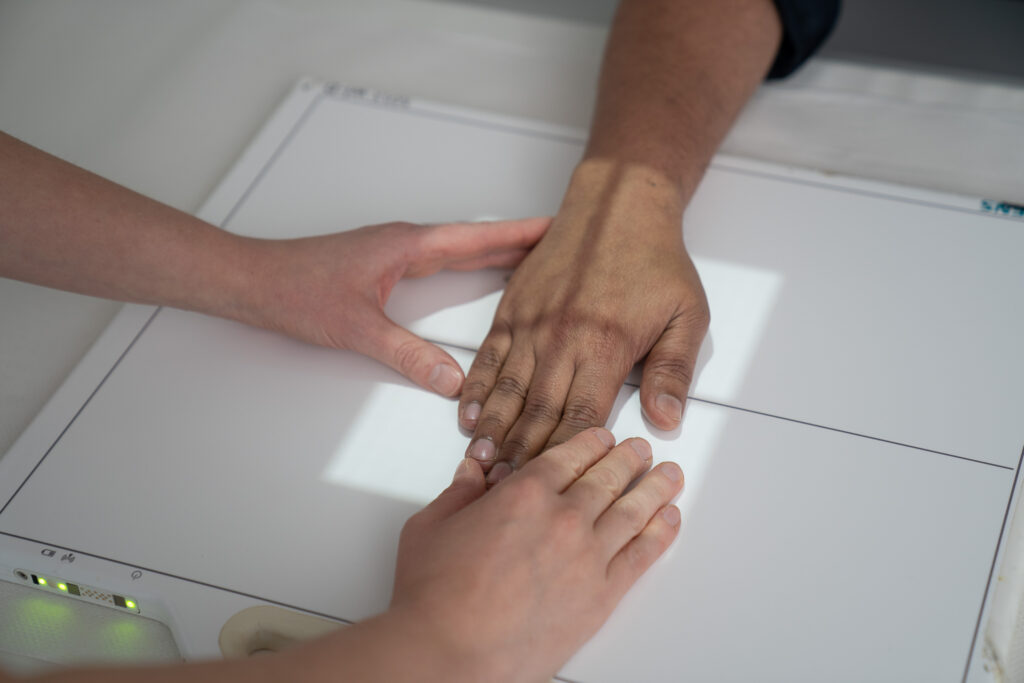What is hand arthritis?
Hand arthritis is a condition characterised by the inflammation of the joints in the hands, leading to joint pain, stiffness, and swelling. The most prevalent type is osteoarthritis, which results from the gradual wearing away of cartilage. As the cartilage deteriorates, bones begin to rub against each other, causing pain and limiting joint movement. Another common form is rheumatoid arthritis, an autoimmune disorder where the immune system attacks the arthritic joint tissues, leading to progressive pain and stiffness. Arthritis of the hand can significantly impact daily activities and overall quality of life.
In osteoarthritis, joint pain typically develops slowly, often affecting the joint closest to the fingertip. On the other hand, rheumatoid arthritis can start with flu-like symptoms and significant stiffness that lasts longer than an hour.
Initial indicators of hand arthritis involve cartilage wearing away, resulting in pain and restricted joint movement. As the condition progresses, it can lead to more severe symptoms and impact daily life significantly.
Symptoms of hand arthritis
The symptoms of hand arthritis can vary but often include:
- Joint pain and stiffness, especially in the morning or after periods of inactivity
- Difficulty performing everyday tasks, such as gripping objects or typing on a keyboard
- Visible swelling in the affected joints, making them appear larger or knobbly
In some cases, affected joints may develop a grating sensation during movement or fluid-filled lumps known as cysts. These changes can significantly impact hand function and lead to a decrease in the quality of life. Recognising these symptoms allows for early diagnosis and better management of hand arthritis.
Causes and risk factors
Hand arthritis can develop due to several factors, including wear and tear of the joint, genetic predisposition, and structural abnormalities such as abnormal cartilage. Injuries to the hands, such as fractures or dislocations, can also increase the likelihood of developing arthritis over time. These injuries can cause long-term damage to the joints, making them more susceptible to arthritis.
Genetic factors play a significant role, with certain inherited traits leading to a higher risk of developing arthritis. Additionally, conditions like Type 2 diabetes are linked to a higher prevalence of arthritis, as hyperglycaemia can damage cartilage health and exacerbate osteoarthritis.
Controlling diabetes and adopting a healthy lifestyle can reduce these risk factors and slow the progression of hand arthritis.
Please call to enquire about the price
Ways to payBefore treatment
During your initial consultation for hand arthritis treatment, your hand & wrist surgeon will start by asking about your symptoms, such as pain, stiffness, swelling, and any difficulty with hand movements. They’ll want to know how long you’ve been experiencing these issues, when they tend to occur, and if there’s a family history of arthritis. After discussing your medical history, they’ll perform a physical examination, checking your range of motion, strength, and any signs of inflammation or deformity in your hand joints. To help diagnose the type of arthritis, your doctor may recommend tests like X-rays, blood work, or other imaging studies. Based on this information, they’ll create a treatment plan tailored to you, which could include medications, physical therapy, splinting, or even surgery, depending on how severe your condition is. The aim is to help you manage symptoms, improve hand function, and slow down the progression of the arthritis.
Analysing joint fluid from swollen joints can help differentiate hand arthritis from other conditions. This comprehensive approach ensures an accurate diagnosis and helps in formulating an effective treatment plan.
During treatment
Non-surgical treatments
Non-surgical treatments for hand arthritis focus on pain relief and improving joint function. Treatment options depend on the severity of symptoms and their effect on daily activities.
Options include pain relief medicines, physical therapy and exercises, and assistive devices, each playing a crucial role in managing the condition effectively.
Pain relief medicines
Over-the-counter medications like ibuprofen are often recommended to manage arthritis pain. NSAIDs such as naproxen can reduce inflammation and provide significant pain relief. These medications can help to treat arthritis and come in various forms, such as tablets and topical creams.
Topical treatments like capsaicin cream and diclofenac gel can also help reduce arthritis pain. Capsaicin cream may require up to a month for full pain relief but remains a valuable option for symptom management. For more severe pain, doctors may prescribe opioids, but these are usually for short-term use due to potential side effects like drowsiness and constipation. Steroid injections are another option for reducing inflammation when oral medications are ineffective.
Paracetamol is often suggested for pain relief in osteoarthritis cases and can be purchased over-the-counter. Patients should adhere to the recommended dosage and seek guidance from their GP. Pain medication choice depends on pain severity and other health conditions.
Physical therapy and exercises
Physical therapy and exercises play a key role in managing osteoarthritis by relieving pain and enhancing joint flexibility. Range-of-motion exercises maintain hand flexibility, crucial for those with osteoarthritis. Manual therapy by a physiotherapist can enhance joint mobility and alleviate pain.
Yoga has been found to help alleviate pain, improve function, and reduce stiffness in patients with osteoarthritis. Engaging in regular exercise boosts blood flow to the joints, fostering joint health and symptom reduction.
Assistive devices
Assistive devices such as splints and tap turners can significantly reduce joint strain and make daily tasks easier for individuals with arthritis. These devices help conserve energy and improve the quality of life by minimising the effort required for routine activities.
Occupational therapists offer valuable advice on selecting and using assistive devices effectively. They can recommend specific tools tailored to individual needs, ensuring maximum benefit and comfort.
Surgical options
When non-surgical treatments fail to provide adequate relief, surgical options may be considered to manage severe hand arthritis. Surgical treatments like joint fusion and joint replacement can significantly improve symptoms, mobility, and overall quality of life, although they may not fully eliminate symptoms.
Knowing the benefits and limitations of each surgical option aids in making an informed decision.
Joint replacement surgery
Joint replacement surgery, also known as arthroplasty, aims to alleviate pain and restore function in severely damaged joints. The procedure involves replacing the damaged joint with an artificial one made of materials like ceramics, long-wearing metal, and special plastics. Joint replacements can significantly improve the quality of life for patients suffering from joint pain.
Resurfacing, a newer technique often used for younger patients, can make an artificial joint last up to 20 years. The surgery can markedly enhance quality of life by alleviating pain and improving joint mobility.
Joint fusion
Joint fusion surgery permanently connects the bones in a joint, providing stability and pain relief. Although this procedure decreases joint movement, it increases strength and reduces pain in the affected area.
Joint fusion effectively provides increased joint stability and pain relief for those with severe arthritis.
After treatment
Post-surgery care
After surgery, keeping the arm elevated above the heart can effectively reduce swelling and pain. Using ice packs on the surgical area for the first three days post-operation can help minimise swelling. A sling may be recommended to immobilise the hand and assist in healing, depending on the type of surgery.
Long-term recovery varies based on the specific procedure and underlying conditions. Follow-up appointments are typically scheduled 10-14 days after surgery to monitor recovery progress. Moving other parts of the body while keeping the hand still can prevent stiffness and swelling.
Lifestyle adjustments
Keeping a healthy weight is vital for managing osteoarthritis since excess weight stresses the joints. Excess weight can accelerate the progression of osteoarthritis. For those who are overweight, increasing physical activity and adopting a healthier diet is recommended.
A diet rich in fruits, vegetables, whole grains, and lean meats while minimising sugar intake is recommended by the Arthritis Foundation. Light to moderate exercise boosts blood flow to the joints, aiding in joint regeneration.
Ice or heat applied to arthritic joints before and after activities can relieve or ease pain.
Managing co-existing conditions
Managing co-existing conditions like diabetes is vital for those with hand arthritis. Diabetes can exacerbate arthritis symptoms, making it essential to manage blood sugar levels effectively.
Proactively controlling diabetes benefits overall health and mitigates the impact of hand arthritis.
Appointment and Treatment Plan
Appointment
Based on your previous consultation with a doctor, an appointment will be arranged between you and your hand & wrist surgeon.
Treatment plan
During this appointment, you will review your medical history, discuss your symptoms, perform tests and collaboratively decide on the next steps regarding your treatment.
Pre-op assessment
If surgery is an option, then the surgeon and their team will thoroughly assess whether you’re right for the surgery. They’ll consider your current health, any previous issues, and other external matters.
Treatment
Depending on the course of treatment recommended, you’ll be booked in for therapy, consultation or surgery. If you’re recommended for surgery, prior to going through with it, our team will ensure that you’re prepped once again. Once everything is confirmed, you’ll undergo the surgery and then we’ll explain the aftercare instructions.
Aftercare
If necessary, you’ll stay in a ward for a few hours to ensure that you’re ready to go home after the surgery. However, this may depend on the surgery outcome and whether you need moderate or light assistance.
Follow-Up
You’ll come in a few weeks later and we’ll give you one final check-over to ensure that you’re on track for recovery.
Experts
We are proud to provide patients with access to a wide range of clinicians, chosen specifically for their knowledge and reputation in their area of expertise. Our experts align with our values: putting you at the centre of your care and educating you on your options at each step of the journey. We encourage you to learn more about our clinicians and how they can help you below. As always, please contact our patient services team if you require any additional information.
We offer 3 ways to pay for your treatment
We exist to take the stress out of private healthcare.
Our payment options are designed to offer you easy access to our treatments and services. You can choose to pay on the day, spread the cost, or use your private medical insurance.
Our patient services team will guide you through the process, providing clear costs and support throughout your course of treatment so you can focus on the thing that matters most – your health.
Whether you pay in advance, spread the cost, or use your private medical insurance, rest assured you will be receiving exceptional care 365 days a year.
Pay in Advance
Even if you do not have medical insurance, you can still get quick and comprehensive access to private medical care.
We provide transparent pricing from your initial consultation to the completion of your treatment so you know where your stand, every step of the way.
We accept all major debit and credit cards, as well as Apple Pay for UK residents. Please note that we do not accept cash or cheques.
Pay monthly
Paying for your treatment at OSD Healthcare doesn’t need to mean settling the full cost in one go.
Many of our treatments have a pay monthly option that allows you to spread the cost of your treatment over 12 months with no credit checks required.
A minimum spend of £300 does apply. We’ll take your first payment upfront and then arrange a direct debit for your monthly payments thereafter. It’s that simple.
Pay using PMI
We are recognised by all major health insurance companies and with our extensive range of services, there are lots of benefits to using your insurance with us. Our patient services team is here to answer any questions you may have about using your private health insurance with us.
Please bring along your policy details including your scheme details, membership or policy number, expiry date and confirmation of eligibility to claim (i.e. your authorisation number). If you do not have these details with you, we will require payment from you on the day. Patients are liable for any amounts not settled by their insurer.
FAQs
Squeezing a ball can be beneficial for arthritis by strengthening hand muscles and improving overall function. However, it’s important to avoid this exercise during acute flare-ups.
Common symptoms of hand arthritis include joint pain, stiffness, swelling, and a grating sensation during movement. These signs can significantly impact daily activities and quality of life.
Non-surgical treatments for hand arthritis include pain relief medications, physical therapy, and the use of assistive devices to enhance daily function. These options can significantly help manage symptoms and improve quality of life.
You should consider surgery for hand arthritis when non-surgical treatments no longer relieve your symptoms and your daily activities are significantly impacted.
Managing hand arthritis can be effectively done by maintaining a healthy weight, following a nutritious diet, engaging in regular exercise, and incorporating relaxation techniques into your routine. These lifestyle changes can alleviate symptoms and improve your overall well-being.




